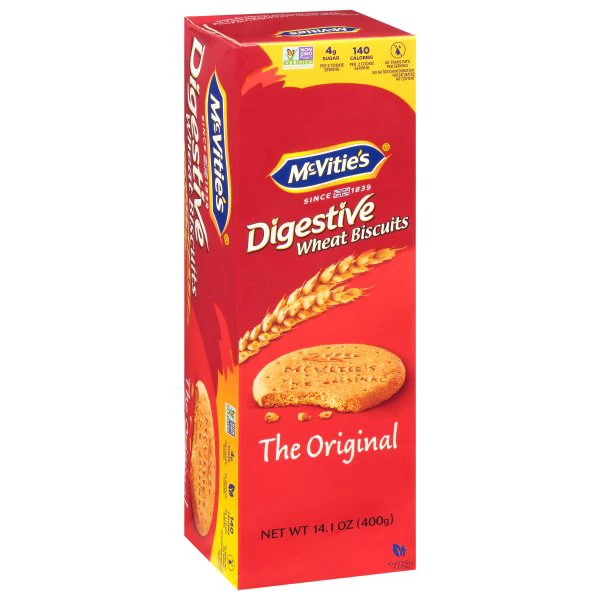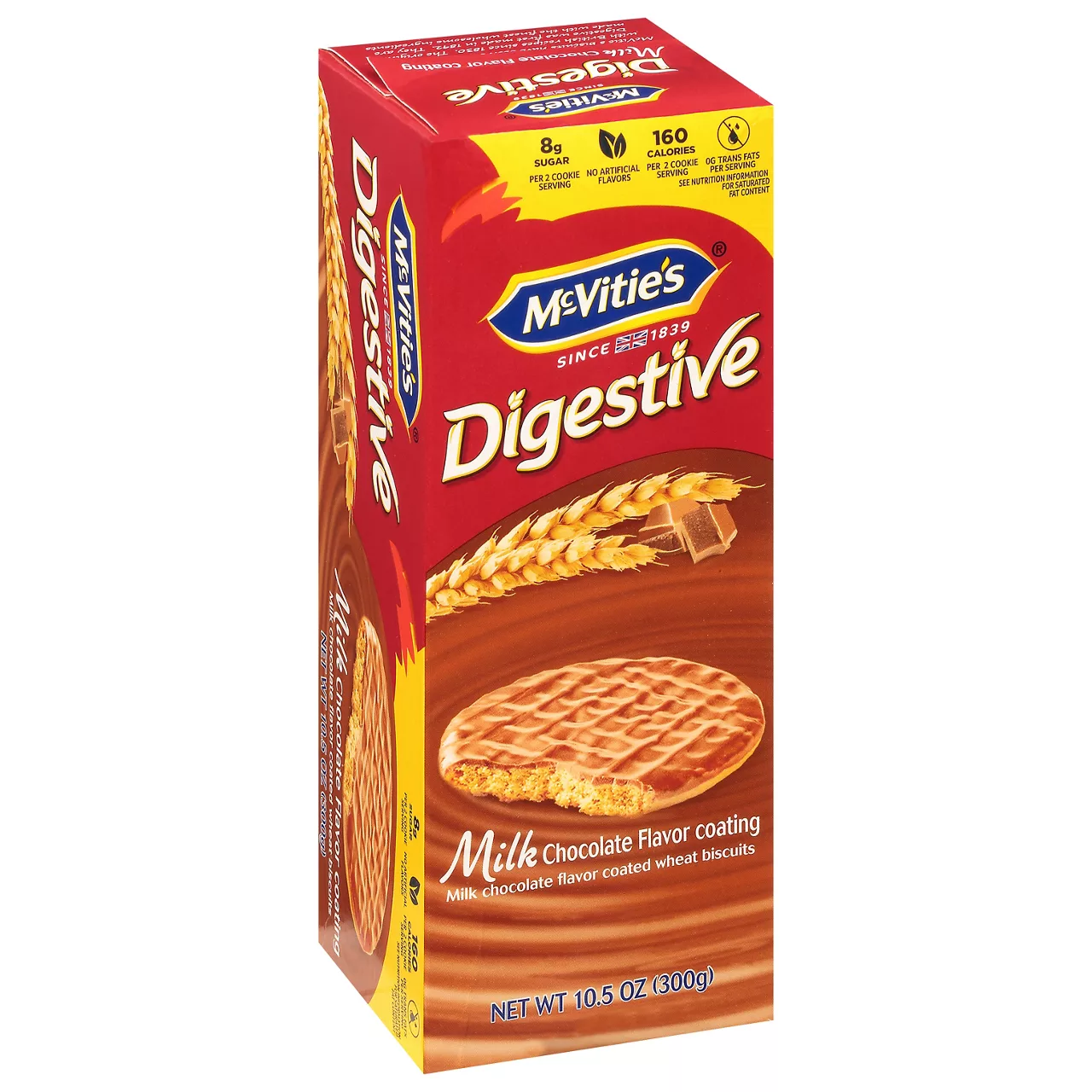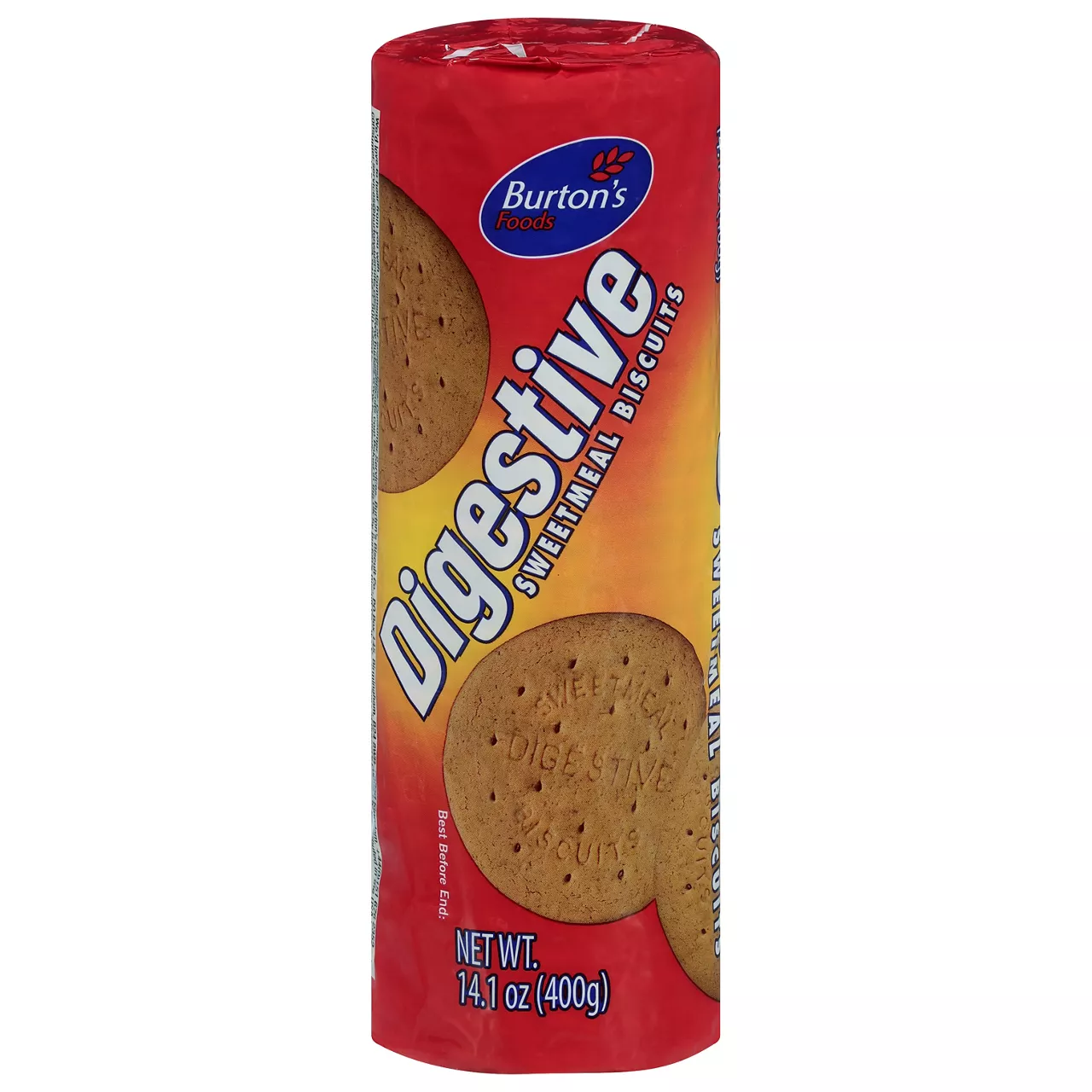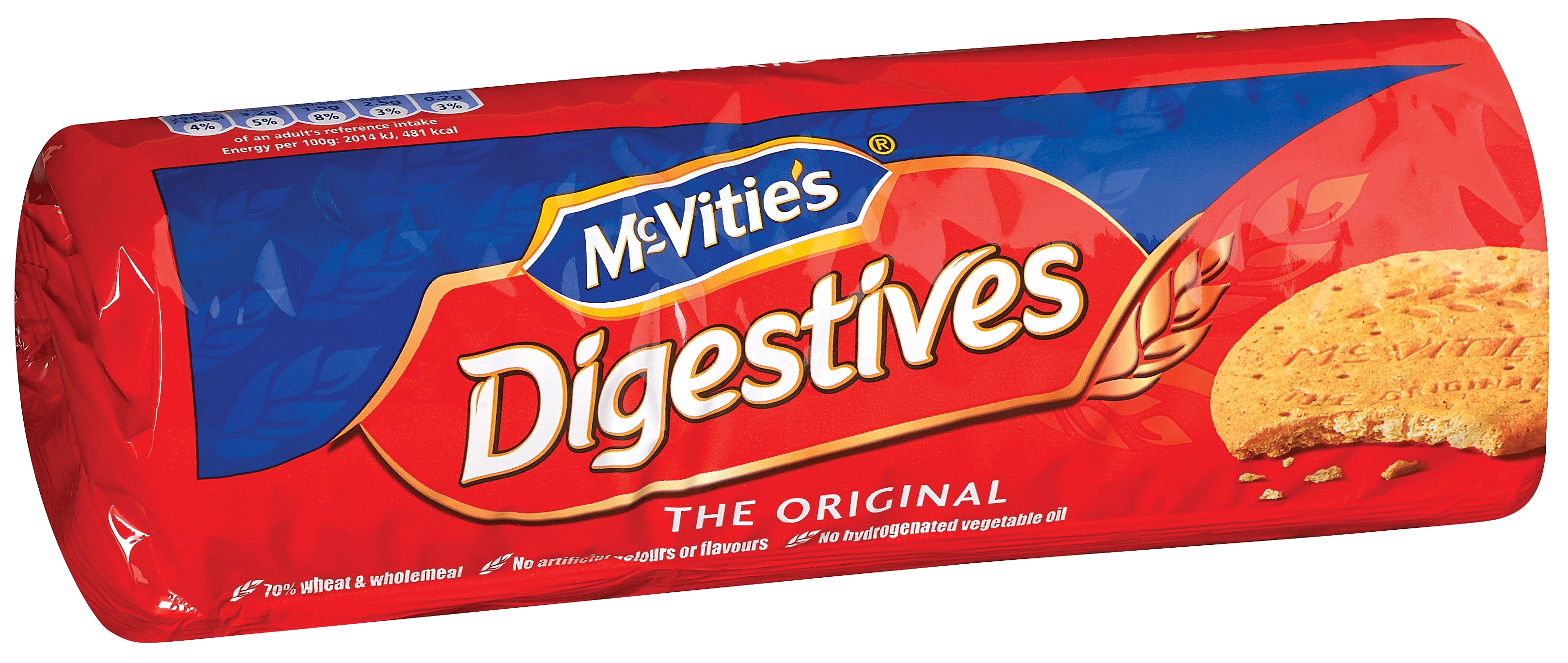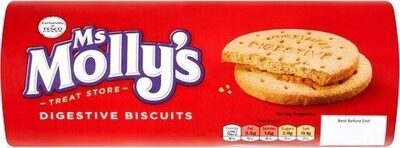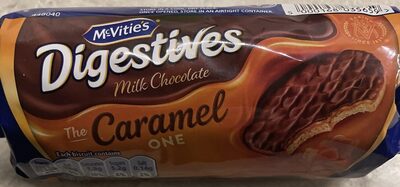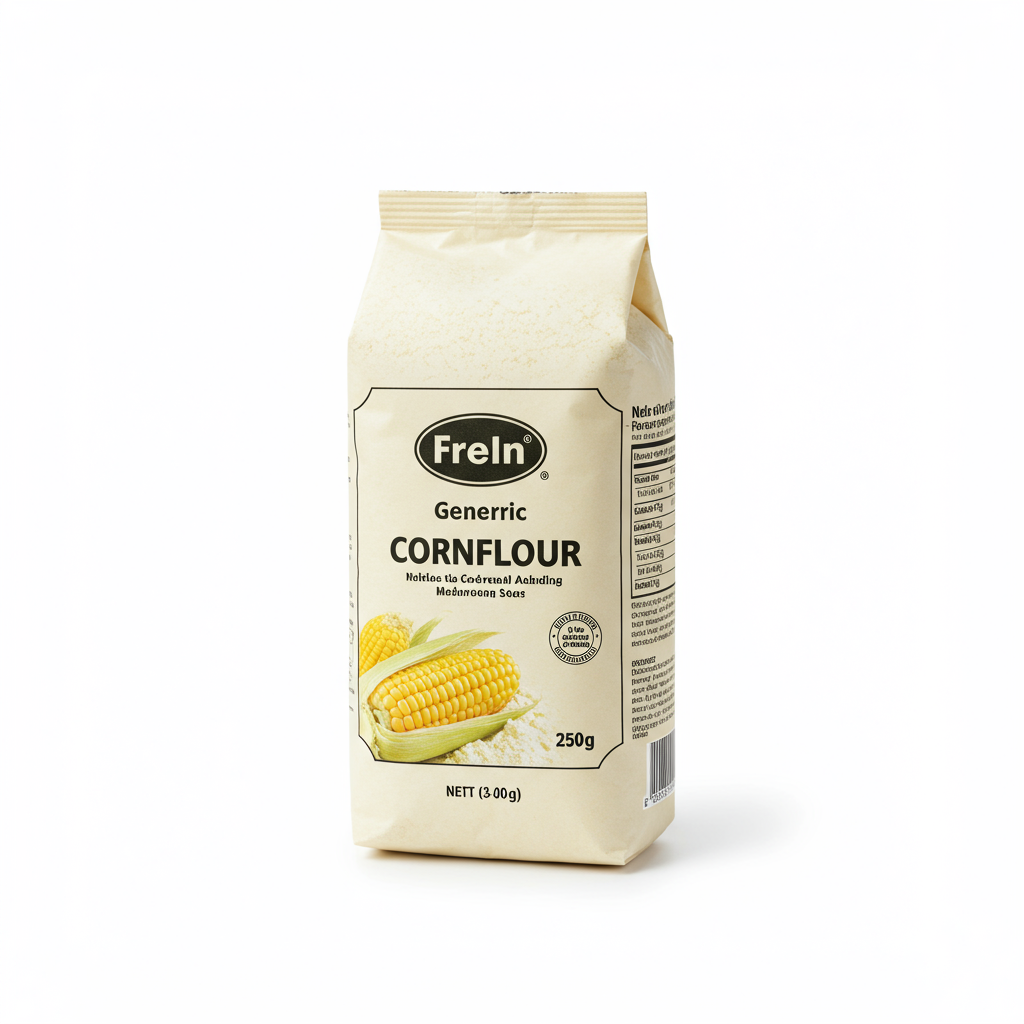Digestive Biscuit
Digestive biscuits are a type of slightly sweet, semi-hard wheat flour-based biscuits, originating from the United Kingdom in the early 19th century. The unique name is derived from the belief that these biscuits had antacid properties due to the incorporation of sodium bicarbonate (baking soda) as one of their key ingredients. These biscuits are a staple in British homes and have gained popularity worldwide for their distinct taste and texture.
Typically enjoyed as a light snack or as an accompaniment to hot beverages, digestive biscuits are often used as a base for various dessert recipes, such as cheesecakes and tarts. With a crumbly texture that readily absorbs liquid, they create a perfectly firm and flavorful crust when combined with melted butter or other binding agents. Digestive biscuits can also be found coated with chocolate, offering a slightly more indulgent treat.
69%
CARBS
24%
FAT
7%
PROTEIN
100 Digestive Biscuit Products
McVitie's Digestive Biscuits, Wheat, The Original
McVitie's Digestives Biscuits Milk Chocolate Flavor Coating
Burton's Biscuits, Sweetmeal, Digestive
McVitie's McVities Digestives The Original
Mcvitie's Digestives Biscuits, Dark Chocolate Flavor Coating
H-E-B Digestive Authentic European Style Cookies
Britannia Digestives Sugar Free Biscuits
Mcvities Digestives dark chocolate
Tesco Digestive
McVities Digestives The Caramel One
Used In 10 Recipes
5
No Bake Cheesecake Bars
2
Amaretto Cherry Cheesecake
6
The Easiest Ever No Bake Blueberry Cheesecake
1
No-Bake Key Lime Pie
3
Blueberry Cheesecake with Blueberry Topping and Lemon Whipped Cream
No-Bake Cherry Cheesecake
Pumpkin Cheesecake with Pecan Caramel Topping
Sour cherry cheesecake
Digestive Biscuit Is Frequently Used With
Digestive Biscuit FAQ
One of the most common issues people face when cooking with digestive biscuits is getting the right texture when using them for dessert bases. They need to be crushed to the right consistency - not too chunky and not too fine, to form a firm base for things like cheesecakes and tarts. Over-blending them could create a paste-like texture, which won't provide the desired crunchy base, and large chunks may not stick together well, causing the base to fall apart. Another aspect people struggle with is figuring out how much butter to use to bind them for crusts. Too little might not hold the crust together, while too much could make it greasy.
For the best results, begin by placing the biscuits in a zip-top bag and crushing them using a rolling pin. Keeping an eye on the consistency is crucial here, aim for a uniform crumb, similar to breadcrumbs. As for butter, use melted unsalted butter and gradually add it to the crushed biscuits until it combines like wet sand. Press gently into your baking tin for a perfect crust.
As a tip for those who love a little extra, consider blending in some nuts - like almonds or pistachios - with the biscuits. This not only adds to the flavor but also gives an interesting texture to your dessert. Little known fact: If you're conscious about your sugar intake, you can also choose wholemeal digestive biscuits which are slightly lower in sugar than the regular ones.
Can I use digestive biscuits for cheesecake crusts?
What can I substitute for digestive biscuits in a recipe?
Can I use chocolate-covered digestives for a dessert base?
How to make a gluten-free version of a dessert using digestive biscuits?
Why are my biscuit bases turning out too soft?
How to crush digestive biscuits without a food processor?
Why are my digestive biscuits falling apart when I try to cut my pie/tart?
Can I add flavors to my digestive biscuit base?
Can I use digestive biscuits to thicken my dessert?
Are digestive biscuits healthy?
Expiration & Storage Tips
When does digestive biscuit expire?
Digestive biscuits, when unopened, can usually last for about 6 to 8 months past the 'best by' date printed on the packet. Once opened, the biscuits may retain their quality for 1 to 2 weeks when stored properly. However, if kept in a closed container in a cool and dry place, they can last for up to 2 months. If you freeze the biscuits, they can last for around 12 months, although the texture may change slightly upon defrosting.
How do you tell if digestive biscuit is bad?
Recognizing spoiled digestive biscuits is quite straightforward. Firstly, check if there's any mold growth. This could be fuzzy or discolored spots on the biscuits. Secondly, if the biscuits develop a strange odor that wasn't previously there, it's probable that they've gone bad. Lastly, the texture changes. If the biscuits become stale, they will lose their trademark crunch and may become tough or chewy.
Tips for storing digestive biscuit to extend shelf life
• Keep digestive biscuits in their original packaging, if possible, until you open them. This helps to retain their freshness.
• Once opened, store the biscuits in an airtight container with a locking lid or a resalable bag.
• Store digestive biscuits in a cool, dark place, away from any sources of heat and not directly under the light. Too much light or heat may turn your biscuits stale.
• If freezing the biscuits, wrap them in a double layer of plastic wrap and then put them in a freezer bag before freezing. To defrost, let them thaw either on the countertop at room temperature or overnight in the refrigerator.
EXPIRES WITHIN
5 - 8
MONTHS
Substitutes

Tea Biscuit

Speculoos Cookie

Graham Cracker

Vanilla Wafer Cookie

Honey Graham Cracker

Butter Cookie

Arrowroot Cookie

Cinnamon Graham Cracker

Gluten Free Graham Cracker

Gluten Free Cinnamon Cookie
See All
Health Info
Macros
10g
CARBS
3g
FAT
1g
PROTEIN
Allowed on these diets
LOW FAT
HIGH CALCIUM
VEGETARIAN
VEGAN
Contains these allergens
MILK
WHEAT

